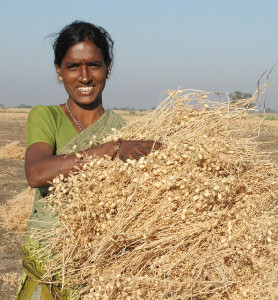Chickpea (Cicer arietinum L.) is the second largest food legume in the world occupying 15 percent of the total pulse area globally and cultivated in almost 52 countries (FAOSTAT, 2012). It currently occupies in 11.98 million hectares with a production of 10.92 million tons (FAOSTAT 2012). Chickpea plays an important role in human diet and animal feed besides it helps in maintenance of soil fertility, particularly in dry lands. The ability of chickpea in fixing nitrogen in soils provides benefits not only to legumes themselves – but also to subsequent crop makes it an important choice in the farming systems.
Chickpea is highly susceptible to climate change, both drought and heat can severely limit its productivity. Drought stress commonly affects chickpea because it is largely grown under rainfed conditions during the post-rainy season on residual soil moisture (Gaur et al. 2008). Terminal drought and heat stress, among other abiotic and biotic stresses, are the major constraints to chickpea production in the warmer short-season semi-arid tropical environments. Inclusion of chickpea in the sequential cropping system resulted in late sowing resulting in prolonged exposure to heat stress during the reproductive phase of chickpea leading to reduction in seed yield. It was observed form the studies that climate change by 2050 may increase the yields of chickpea by 17 to 25% at the cooler sites (Hisar, Indore, Zaloke, Debre Zeit, and Kabete) and decrease yields by 7 to 16% at the warmer sites (Nandhyal and Ukiriguru) as compared to the yields under baseline climate of the sites (Singh et al., 2013)
Predicted climate change scenarios for Asia and Africa include an increase in seasonal temperatures and extreme temperature events. Flowering and podding in chickpea found to be very sensitive to temperature changes and exposure to heat stress (Summerfield et al., 1984). Therefore, breeding for increased heat and drought tolerance are the important priority areas for chickpea research to maintain chickpea productivity in vulnerable areas
The CGIAR Research Program (CRP) on Grain Legumes with ICRISAT as lead center together with partners developed advance research program on high-priority challenges such as development of heat-tolerant chickpea, high nitrogen-fixing chickpea, Insect-smart chickpea and extra-early chickpea to maintain chick pea production in view of anticipated climate change in chickpea growing regions.






